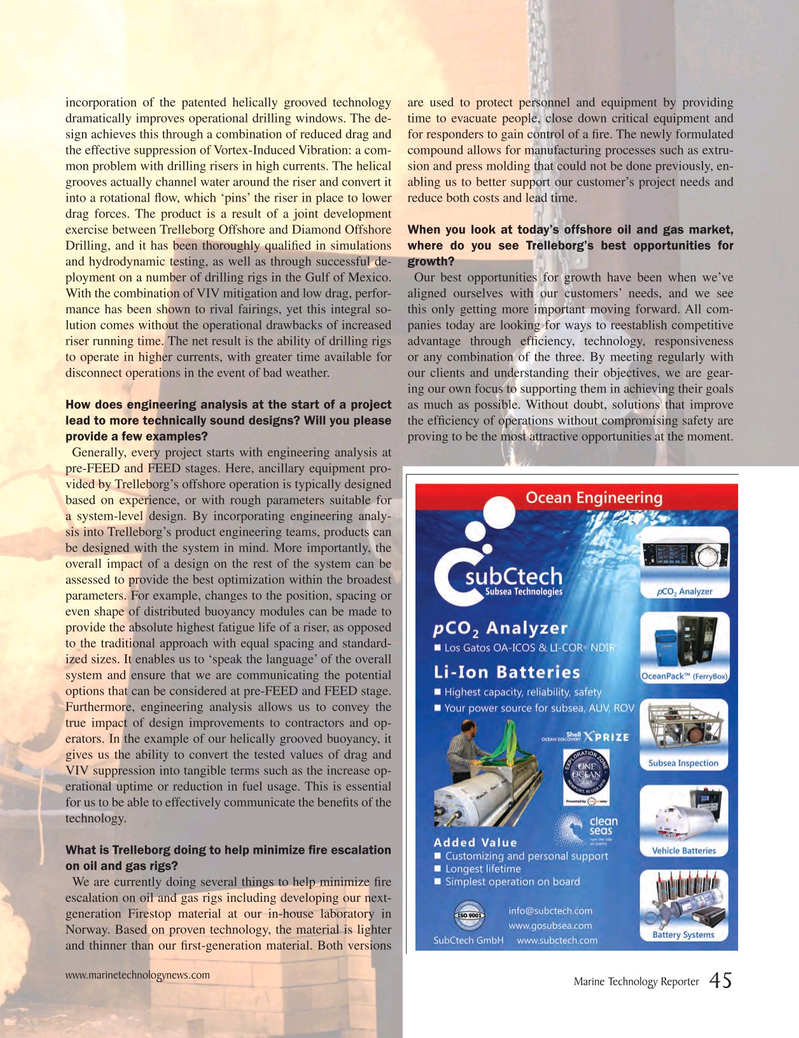
Page 45: of Marine Technology Magazine (May 2018)
Hydrographic Survey: Single beam and Multibeam Sonar
Read this page in Pdf, Flash or Html5 edition of May 2018 Marine Technology Magazine
incorporation of the patented helically grooved technology are used to protect personnel and equipment by providing dramatically improves operational drilling windows. The de- time to evacuate people, close down critical equipment and sign achieves this through a combination of reduced drag and for responders to gain control of a ? re. The newly formulated the effective suppression of Vortex-Induced Vibration: a com- compound allows for manufacturing processes such as extru- mon problem with drilling risers in high currents. The helical sion and press molding that could not be done previously, en- grooves actually channel water around the riser and convert it abling us to better support our customer’s project needs and into a rotational ? ow, which ‘pins’ the riser in place to lower reduce both costs and lead time.
drag forces. The product is a result of a joint development exercise between Trelleborg Offshore and Diamond Offshore When you look at today’s offshore oil and gas market,
Drilling, and it has been thoroughly quali? ed in simulations where do you see Trelleborg’s best opportunities for and hydrodynamic testing, as well as through successful de- growth?
ployment on a number of drilling rigs in the Gulf of Mexico. Our best opportunities for growth have been when we’ve
With the combination of VIV mitigation and low drag, perfor- aligned ourselves with our customers’ needs, and we see mance has been shown to rival fairings, yet this integral so- this only getting more important moving forward. All com- lution comes without the operational drawbacks of increased panies today are looking for ways to reestablish competitive riser running time. The net result is the ability of drilling rigs advantage through ef? ciency, technology, responsiveness to operate in higher currents, with greater time available for or any combination of the three. By meeting regularly with disconnect operations in the event of bad weather. our clients and understanding their objectives, we are gear- ing our own focus to supporting them in achieving their goals
How does engineering analysis at the start of a project as much as possible. Without doubt, solutions that improve lead to more technically sound designs? Will you please the ef? ciency of operations without compromising safety are provide a few examples? proving to be the most attractive opportunities at the moment.
Generally, every project starts with engineering analysis at pre-FEED and FEED stages. Here, ancillary equipment pro- vided by Trelleborg’s offshore operation is typically designed based on experience, or with rough parameters suitable for a system-level design. By incorporating engineering analy- sis into Trelleborg’s product engineering teams, products can be designed with the system in mind. More importantly, the overall impact of a design on the rest of the system can be assessed to provide the best optimization within the broadest parameters. For example, changes to the position, spacing or even shape of distributed buoyancy modules can be made to provide the absolute highest fatigue life of a riser, as opposed to the traditional approach with equal spacing and standard- ized sizes. It enables us to ‘speak the language’ of the overall system and ensure that we are communicating the potential options that can be considered at pre-FEED and FEED stage.
Furthermore, engineering analysis allows us to convey the true impact of design improvements to contractors and op- erators. In the example of our helically grooved buoyancy, it gives us the ability to convert the tested values of drag and
VIV suppression into tangible terms such as the increase op- erational uptime or reduction in fuel usage. This is essential for us to be able to effectively communicate the bene? ts of the technology.
What is Trelleborg doing to help minimize ? re escalation on oil and gas rigs?
We are currently doing several things to help minimize ? re escalation on oil and gas rigs including developing our next- generation Firestop material at our in-house laboratory in
Norway. Based on proven technology, the material is lighter and thinner than our ? rst-generation material. Both versions www.marinetechnologynews.com
Marine Technology Reporter 45
MTR #4 (34-49).indd 45 MTR #4 (34-49).indd 45 5/10/2018 10:41:24 AM5/10/2018 10:41:24 AM

 44
44

 46
46
